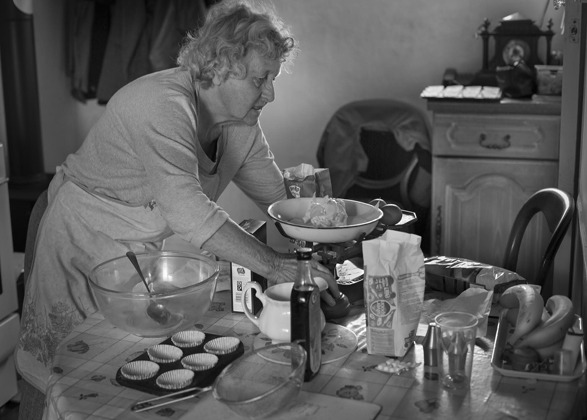Of Life and Land: an interview with photographer Lucy Saggers

Lucy Saggers has lived in Ampleforth since 2004 and worked as a photographer since 2013. Lucy works in black and white to focus on what, to her, are the essential components of composition, texture and light, feeling that this way she can get closer to the timeless essence of a scene. Using prime lenses and available light, she produces her photographs as limited edition, archive prints on fine art paper.
Lucy has printed her exhibition prints on our new Platinum Cotton 305 paper.
You can find out more about Lucy here.
Lucy Saggers’ latest exhibition, Of Life and Land, showcases the relationships between people, community and place. The curated collection of black and white, documentary photographs came about gradually after Lucy moved to the deeply rural North Yorkshire village of Ampleforth. She was struck by the beauty of everyday life and felt increasingly rooted by the sense of permanence derived from the deep layers of connection among the community and its landscape. ‘I am inherently drawn to the timelessness of black and white. I think it focuses on what are, to me, the essential components of composition, texture and light. I feel that black and white allows me to get closer to the essence of a scene.’ Lucy began by documenting the landscape, and then gradually to capture the ordinary, everyday goings-on in and around the village.

Lucy’s inspiration for this work initially came from the photographer James Ravilious, who documented rural life in Devon during the 1970s and 1980s. ‘Having said that’, Lucy says, ‘to take a photograph is my instinctive response to seeing something that I treasure, and so this project seems completely intuitive. I try to work steadily and unhurriedly, with the aim of allowing an understanding and trust to evolve between myself and the people I am photographing. The work is wholly dependent on this mutual trust and honesty.’
The exhibition came about through significant input from several people – curator Andy Dalton, and Jennifer Smith, director of the Ryedale Folk Museum (the exhibition’s venue until 25th March). Lucy worked with Andy and Jennifer to select the exhibition images. ‘They were firm but fair(!)’, Lucy says, ‘and I loved working with them – I find selecting my own images incredibly difficult. I was also very lucky to have the opportunity to work with Joe Cornish, to make the exhibition prints and to learn something of his processing and printing expertise.’
Thanks to funding from Ryedale District Council, Lucy has produced a book, Of Life and Land, to accompany the exhibition, with a foreword by Ian McMillan (see below). The book is available from Lucy’s website www.lucysaggers.com.
The exhibition has been open for a couple of weeks at its North Yorkshire venue of The Ryedale Folk Museum, Hutton-le-Hole, and there have been a wide range of visitors, from local residents, to visitors on holiday in the area, as well as photographers and artists. ‘I’ve been truly delighted with the feedback. For example, somebody who does not usually like black and white photography commented on how much they loved these photographs. Another couple said it was the highlight of their stay on the North York Moors.’ Lucy has also received positive feedback from photographers and curators, calling the exhibition a ‘very special and unusual body of work’ and ‘a must see.’

On why she thinks it is important to print photographs, Lucy says, ‘I think printing photographs is important because it gives the viewer time to digest and engage with an image. We are bombarded by digital images and therefore we probably have a tendency to rush past many of them: prints can help us to slow down and see. A print has an intrinsic value as a physical entity, with its own individual characteristics and journey: this tangible, material value, along with their permanence, are qualities that will always be missing from a digital image.’ Seeing the Of Life and Land images printed, many of them for the first time, has been a joy for Lucy, ‘because it is at that point the photographs become something physical. In that sense, the prints are the culmination of the making process, and there is huge satisfaction in reaching that point.’
For Of Life and Land, every image was specifically printed for the exhibition, giving the end result a particular coherence. ‘It is the first time I have printed on Platinum Cotton 305, which I think works beautifully for my images. I particularly love the paper’s delicate warmth and slight texture; and it has captured all the definition in the blacks.’

Lucy advises that putting on an exhibition is not to be underestimated in terms of both time and financial input. With sufficient planning and support, it is such a rewarding thing to do. Promoting exhibitions and keeping conversations going about the beauty and value of prints as something permanent and tangible is a key part of encouraging people to get out and see printed photographs.
So, what does the future hold for Lucy? After the Ryedale Folk Museum, Of Life and Land will tour, in July, to The Witham in Barnard Castle, County Durham. Lucy is currently working to add further venues for 2018 and beyond, as well as to distribute the accompanying book of photographs. ‘Photographically, I will continue documenting life in rural North Yorkshire (there are always more stories to tell), as well as working on commissions.’
Of Life and Land is at Ryedale Folk Museum, Hutton-le-Hole, from February 10th to March 25th 2019.
OF LIFE AND LAND foreword by Ian McMillan
These wonderful photographs are poems and short stories; they are miniatures and epics; they are tiny movements at the edge of the folding map and huge gestures at the vortex of the turning world. Lucy Saggers has concentrated her sympathetic and empathetic lens on the village and surroundings of Ampleforth in North Yorkshire, a place that, as WB Yeats said about somewhere else, is ‘far from the centre of things’ except that in Lucy’s images it isn’t. It is a place that reverberates like a struck gong, sending messages to us all about how we might live if only we could stop and look and pay attention. These photographs, once seen, cannot be unseen. They hang around in the viewer’s mind, returning in the moments before sleep or on train journeys through the afternoon.
Lucy Saggers’s images have the timelessness of cave paintings but, somehow, the modernity of Instagram. Here is a man following a flock of geese; here is someone standing by an empty bier. Here is a woman baking, and we know that the recipe is not in a book but in her head in the voice of her grandma. Here they are: they are us. We share their humanity and they amplify ours.
Here is the universal in the local, the idea that, if you gaze out of the same window (or across the same field) for long enough, the whole world will pass by. Lucy’s Ampleforth is like the poets George Mackay Brown’s Orkney Islands or Norman Nicholson’s corner of Cumbria; small stages on which almost operatic action can take place. In these photographs Ampleforth is a prism through which we can view so many truths, so many possibilities. Lucy has captured a place that moves to ancient and unspoken rhythms of sunrise and sunset, of birth and death and the unending dance of the seasons.
And yet there could almost be a sense of elegy here. Many of the human subjects of the photographs are elderly, their hair lit grey in the black and white of the indoors and outdoors. But this is not a looking back: this is a looking around. These photographs capture a particular slice of the world as it is, not as it was. Any elegiac feelings are conjured in the viewer’s mind and should be drowned out by the noise of the geese.
Enjoy this book; swim around in these deep, deep photographs and then look around your own street, your own village, your own neighbourhood and try and find the timeless stories there because in the end none of us, as Lucy Saggers proves, are very far from the centre of things.
If you would like to stay on top of all the latest information from Fotospeed don't forget to sign up to our Newsletter.



